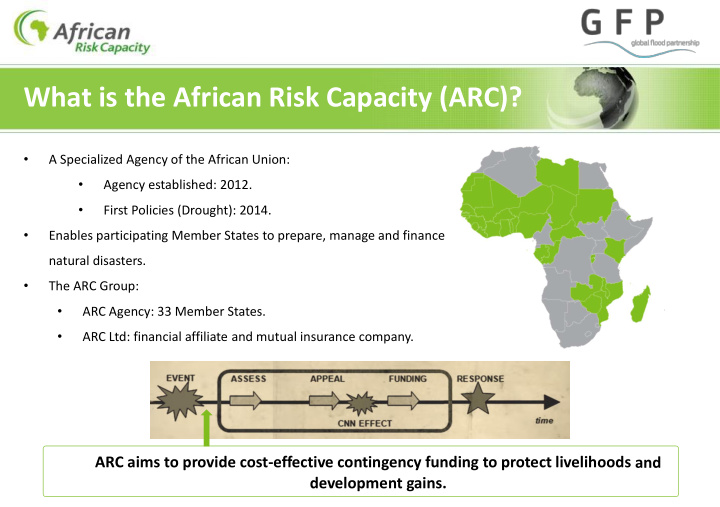



What is the African Risk Capacity (ARC)? • A Specialized Agency of the African Union: • Agency established: 2012. • First Policies (Drought): 2014. • Enables participating Member States to prepare, manage and finance natural disasters. • The ARC Group: • ARC Agency: 33 Member States. • ARC Ltd: financial affiliate and mutual insurance company. ARC aims to provide cost-effective contingency funding to protect livelihoods and development gains.
ARC and Sovereign Disaster Insurance Tropical Cyclone IDAI – AFED Depictions & TC Data • Drought Insurance Policies Issued by ARC Ltd since 2014: • Payouts of approximately 38 million USD to member states – Senegal, Mauritania, Niger, Malawi. • > 2,2 million people have been alleviated from drought impact through ARC’s insurance framework. • ARC Ltd. is expanding its portfolio to cover natural disasters resulting from: • Outbreaks & Epidemics ( O&E ), • Tropical Cyclones ( TC Model ). • Large-scale River Flooding ( AFM-R ).
What is the ARC River Flood Model (AFM-R)? AFM-R INDEX EXPOSURE DATA MODELLED IMPACT 1 DAILY FLOOD DEPICTION (AFED) 0 RESPONSE COSTS USD SUB RIVER BASIN AGGREGATION 0 RISK TRANSFERRED TO ARC
The 2019 West-African AFM-R Pilot • Cote d’Ivoire, Ghana, The Gambia, Togo. • Flood cycle: 12 months; inception will be aligned with drought insurance timeline. • Monitoring of the season from May/June onward. • September/October/November: countries decide whether they would like to take out river flood insurance.
What is the ARC Flood Extent Depiction (AFED) dataset?
What we know about AFED • Necessary criteria for insurance purposes : • Method objectivity, consistency & transparency • Continuous temporal coverage (1998 – present) • Depicts long-lasting (>2 – 3 days) large-scale flooding in wide (>2 km) flood plains • Detects non-permanent water through clouds • At polygon-aggregated level – ideal for use in insurance-underwriting to cover large-scale river floods • Constraints: signal interference from rain; small- scale flooding; flash floods; urban & coastal flooding
What we don’t know about AFED • How well does it depict true ground conditions ( Overall Depiction Accuracy )? • How does it compare to other existing flood- extent depictions and Global Flood Models ( GFM s)? • How does it compare to existing forecasting systems and hydrometeorological data? • Combined with exposure, how well does it detect flood events characterised by combinations of small/large scale versus low/high impact ? • Can it be used for forecasting and/or Early Warning ( EW )?
AFM-R and the Disaster Cycle
The 2019 Flood Information System (FIS) Prototype • Building on the strength of High Temporal Coverage of AFED Data and High Spatial Resolution of alternative satellite-derived Flood Extent Depictions. • Allows for: • Faster and more efficient decision-making • Reduce loss from flooding amongst the general population • Improve the ARC flood service offerings in the countries by providing access to flood maps and custom impact analytics via a near real- time platform during the 2019 rainy season
The way forward for AFED • Technical Review Forum ( TRF ) Recommendation (February, 2019): “ Introduce & make available AFED to a wider pool of experts , stimulate research that may result in peer-reviewed publications that could potentially yield additional information regarding the performance, accuracy and further applications of the dataset.” • Come and engage with us: Elke Verbeeten Johan Vermeulen • Flood Model Development Manager • GIS & Data Specialist • elke.verbeeten@africanriskcapacity.org • johan.vermeulen@africanriskcapacity.org THANK YOU
Recommend
More recommend